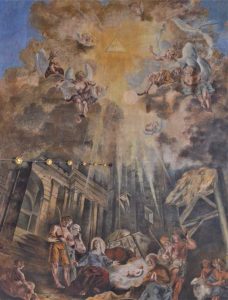The Nativity in the stable in Bethlehem is rarely missing from the pictures usually found in Lutheran churches. In Bayreuth’s Collegiate Church and in Weidenberg (illus.)  it is found right at the centre of the ceiling painting. In the picture cycles we see representations of the archangel Gabriel’s Annunciation to Mary (‘Annunciation’), the Adoration of the Shepherds and the Adoration of the Magi. Above the earthy scenes, a shining Heaven opens and God himself appears, surrounded by His angels. They proclaim to all men ‘Glory to God in the highest and peace to His people on earth!’ This heavenly ‘Glory to God!’, the ‘gloria patra’ becomes ‘All glory be to God in the Highest’ (latin: ‘Soli Deo Gloria’).
it is found right at the centre of the ceiling painting. In the picture cycles we see representations of the archangel Gabriel’s Annunciation to Mary (‘Annunciation’), the Adoration of the Shepherds and the Adoration of the Magi. Above the earthy scenes, a shining Heaven opens and God himself appears, surrounded by His angels. They proclaim to all men ‘Glory to God in the highest and peace to His people on earth!’ This heavenly ‘Glory to God!’, the ‘gloria patra’ becomes ‘All glory be to God in the Highest’ (latin: ‘Soli Deo Gloria’).
Just before, the angel has encouraged the terrified shepherds: ‘Be not afraid! See, I bring you glad tidings of great joy, which will be to you and all people, for unto you is born today a Saviour.’ This joyous message contains the whole Gospel: the Saviour – born for you.That is why Martin Luther loved the Christmas story so much – the eternal God becomes man and allows himself to take the form of this child. God comes down into the very poorest circumstances. Luther says: ‘We understand no other God but the one who came from Heaven and is in every person. I will begin with the manger.’ The reformer composed several Christmas carols such as ‘ Von Himmel hoch’ : (‘I come from Heaven above to bring you glad tidings’) The Saviour (Greek ‘soter’) is born , and greets us from many pulpits.